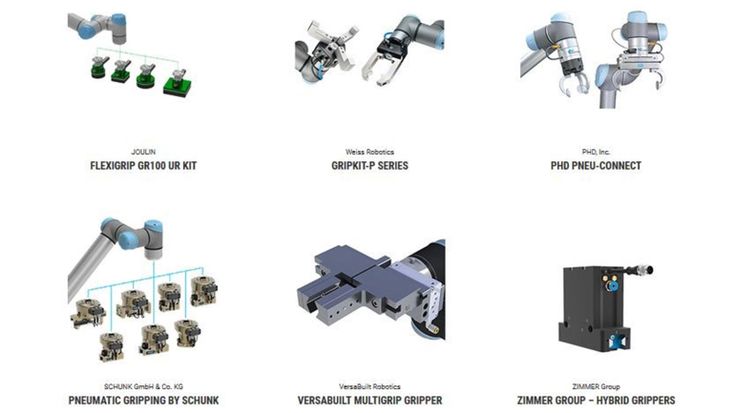Pneumatic and hydraulic grippers are amongst the most popular gripper types (along with servo-electric). If you're wondering whether pneumatic or hydraulic grippers are likely to be the best fit for your application, this article is for you as we compare and contrast the design, performance and usability of hydraulic and pneumatic grippers.
Spoiler: As showdowns go, this one is easy to call. We'll soon discover that for collaborative robot applications, there is no serious competition between the two: pneumatic grippers are the ideal choice for your cobot-powered applications.
Let's find out why...
What is a hydraulic gripper?
Hydraulic grippers are heavy-duty grippers that apply the type of forces required to handle heavy (usually >50kg, 110.23 lb) items.
How does a hydraulic gripper work?
Hydraulic grippers use pressurized fluids to move a piston. When the piston moves, it transfers this force to the claw, opening and closing it.
What is a pneumatic gripper? How does a pneumatic gripper work?
Pneumatic grippers use pressure from a compressed air supply system to supply the power required to move an inner piston, thereby opening and closing the pneumatic gripper fingers (or 'jaws'). Pneumatic gripper mechanisms contain no motors or gears, which makes it easy to translate the power of a piston/cylinder system into a gripping force.
Since the majority of manufacturing facilities already have access to compressed air, deploying pneumatic grippers is easy and cost-effective. One of the main benefits of pneumatic grippers is that they provide a high amount of gripping force in a small, light and low-cost package. For manufacturing facilities where space is at a premium, pneumatic grippers are an economical and ergonomic choice. They are also quite easy to maintain –once you have your pneumatic gripper working, it can provide millions of cycles without requiring maintenance.
What is the difference between pneumatic and hydraulic grippers?
One of the primary reasons why hydraulic grippers are rarely, if ever, used in collaborative automation is because the typical payloads don't match. For reasons of safety, ease of deployment, cost, mobility and footprint, cobots are designed for lower-than-hydraulic payloads of up to around 16kg (35.3 lbs). Therefore, for almost every conceivable cobot-powered application, using a hydraulic gripper would be expensive overkill.
If you need to lift weights of 500kg (1102.31lb), for example, a standard industrial robot with a hydraulic gripper and fencing might be the best choice. But for Universal Robots customers, pneumatics offer perfectly adequate energy density for applications such as assembly, material handling and machine tending.
Additionally, since hydraulic grippers contain pistons and oiled parts, they are much higher-maintenance than their servo-electric and pneumatic counterparts. Hydraulic gripper maintenance is also complex and can require skilled technicians to maintain the oil, pump and reservoir. This highlights another important reason why pneumatic grippers tend to be preferred over hydraulic grippers for collaborative applications: cobots are designed for easy operation by non-expert end-users, so adding a complex hydraulic gripping system to a cobot will undermine the overall system's ease of use.
Since they rely on air rather than fluids, pneumatic robot grippers can be deployed in clean room environments. By comparison, hydraulic robot grippers are too messy –especially when they fail and leak hydraulic fluid into your work cell.
Furthermore, in terms of cost, hydraulic grippers are much more expensive than their pneumatic counterparts. If you are attracted to cobots in part because of their low cost compared to traditional automation, then it doesn't make a lot of sense to deploy a hydraulic gripper that could easily cost more than the cobot itself.
Finally, if accuracy is important to your collaborative application, then keep in mind that pneumatic gripping systems provide greater accuracy than their hydraulic counterparts. Your gripper's URCap software and easy integration with Universal Robots cobot range ensures a constant flow of data that can be used to tweak your applications and processes, reduce downtime and improve productivity.
URCaps are special software programs designed to ensure smooth programming and control of UR certified end-effectors and components. UR+ is a global ecosystem of components, software, and application kits that have been validated and certified to be mechanically, electrically and digitally compatible with cobots from Universal Robots. UR+ hosts a wide selection of pneumatic grippers from you to choose from.
Pneumatic grippers easily win this robot gripper showdown, but they have their own limitations. For example, because they rely on pressurized air flow, force control is not as precise as that provided by electric grippers. Providing a delicate grip can also be a challenge for pneumatic systems since it’s hard to control the gripper at very low pressures. If an external air supply is required, this can add extra cost to your deployment. And while pneumatic grippers are suitable for many clean room applications, if they fail, they can contaminate the air inside the work cell. For these reasons, some manufacturers prefer to use electric grippers for their material handling needs.
UR+ is a one-stop-shop for pneumatic robot grippers
Let's take a look at some of pneumatic robot gripper options available through UR+
The GRIPKIT-P Series from Weiss Robotics is a pneumatic gripper and handling system for Universal Robots. The GRIPKIT-P system contains everything end users need to set up material handling, assembly and machine tending tasks within minutes. If you need high dynamics and gripping force with compact dimensions, GRIPKIT-P pneumatic grippers (in parallel or centric design) are ideal.




